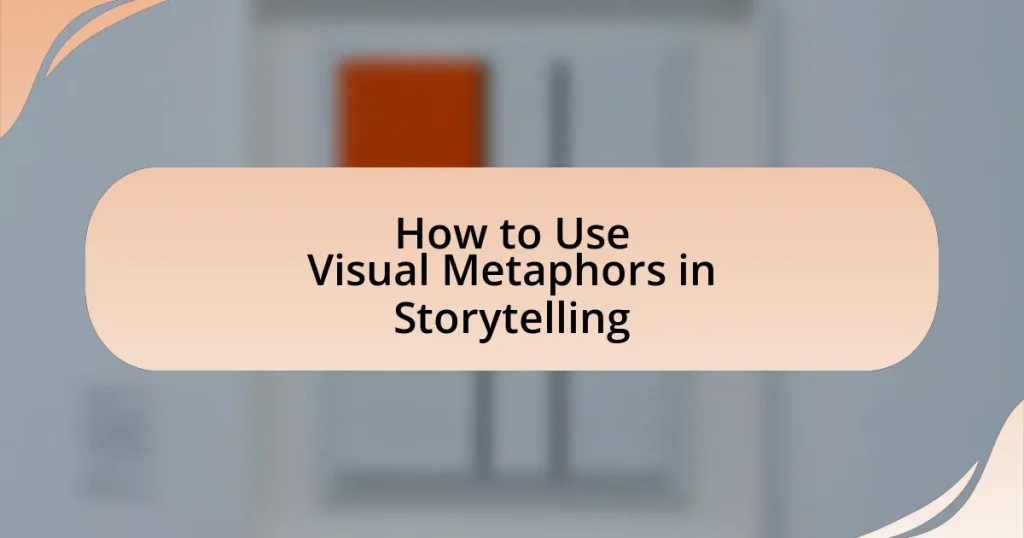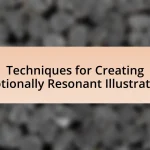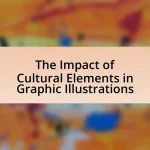Visual metaphors are symbolic images or visual elements that represent abstract ideas, enhancing storytelling by creating deeper emotional connections and facilitating understanding of complex themes. This article explores how visual metaphors enhance narrative depth, influence audience perception, and play a crucial role in character development. It outlines key elements for effective visual metaphors, techniques for their creation, and best practices for their incorporation into storytelling. Additionally, it addresses common pitfalls and offers strategies for refining metaphor usage to ensure clarity and impact, ultimately improving audience engagement and retention.
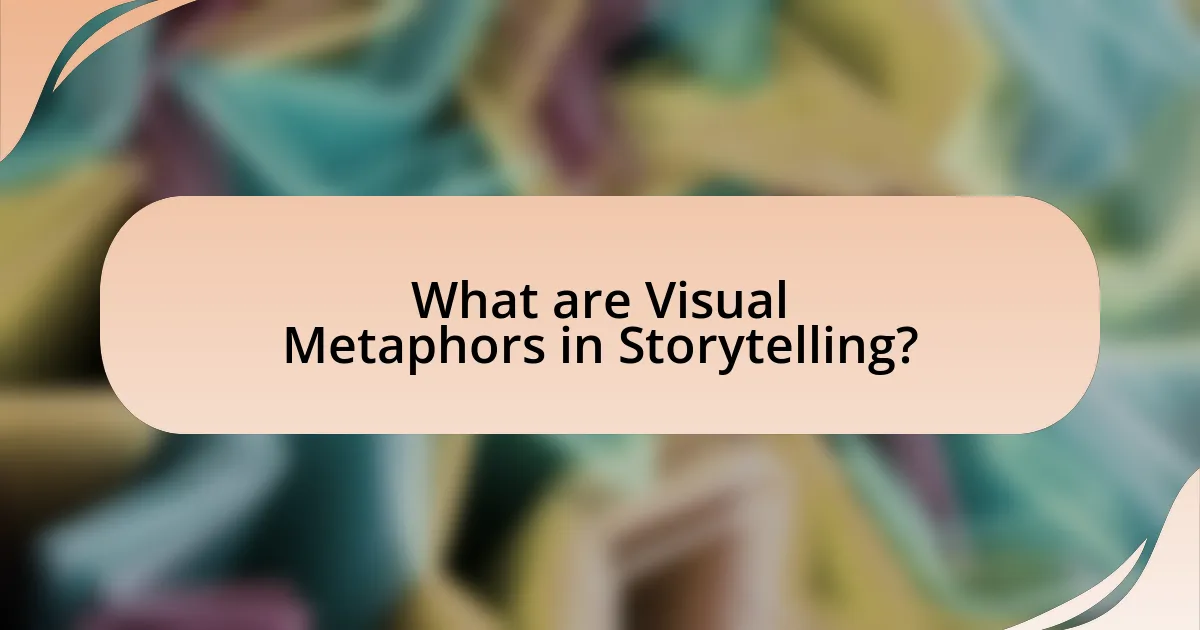
What are Visual Metaphors in Storytelling?
Visual metaphors in storytelling are symbolic images or visual elements that represent abstract ideas or concepts, enhancing the narrative by creating deeper connections. They allow storytellers to convey complex emotions or themes through visual representation, making the story more relatable and impactful. For example, a stormy sky can symbolize turmoil or conflict, while a blooming flower may represent hope or renewal. This technique is widely used in various forms of media, including film, literature, and visual art, to evoke emotional responses and facilitate understanding of the underlying message.
How do visual metaphors enhance narrative depth?
Visual metaphors enhance narrative depth by creating layers of meaning that engage the audience on both emotional and intellectual levels. They allow storytellers to convey complex ideas and themes succinctly, often evoking strong imagery that resonates with viewers. For instance, in film, a recurring visual metaphor, such as a wilting flower, can symbolize decay or loss, deepening the audience’s understanding of a character’s emotional state. Research indicates that visual metaphors can improve retention and comprehension of narrative content, as they facilitate connections between the visual elements and the underlying themes, making the story more impactful and memorable.
What are the key elements of effective visual metaphors?
Effective visual metaphors consist of clarity, relevance, and emotional resonance. Clarity ensures that the metaphor is easily understood, allowing the audience to grasp the intended meaning without confusion. Relevance connects the metaphor to the subject matter, enhancing the narrative by providing a deeper understanding of the themes being explored. Emotional resonance engages the audience on a personal level, evoking feelings that align with the story’s message. For instance, a visual metaphor depicting a storm to represent turmoil can effectively convey complex emotions, making the narrative more impactful.
How do visual metaphors influence audience perception?
Visual metaphors significantly influence audience perception by creating associations that enhance understanding and emotional engagement. They allow audiences to grasp complex ideas quickly by linking them to familiar images or concepts, thereby facilitating cognitive processing. For instance, a visual metaphor like a bridge representing connection can evoke feelings of unity and collaboration, making the intended message more relatable. Research by Forceville (1996) in “Pictorial Metaphor in Advertising” demonstrates that visual metaphors can lead to stronger recall and persuasion, as they engage viewers on both intellectual and emotional levels. This dual engagement enhances the overall impact of storytelling, making the narrative more memorable and effective.
Why are visual metaphors important in storytelling?
Visual metaphors are important in storytelling because they enhance understanding and emotional engagement. By using imagery that represents abstract concepts, storytellers can convey complex ideas more effectively, allowing audiences to grasp themes and emotions quickly. For instance, a broken mirror can symbolize shattered dreams, making the narrative more relatable and impactful. Research indicates that visual metaphors can improve memory retention and comprehension, as they create mental images that resonate with viewers, facilitating deeper connections to the story.
What role do visual metaphors play in character development?
Visual metaphors play a crucial role in character development by providing deeper insights into a character’s emotions, motivations, and transformations. They visually represent abstract concepts, allowing audiences to grasp complex character traits and arcs quickly. For instance, a character surrounded by dark clouds may symbolize inner turmoil or conflict, while a character emerging from a cocoon can signify growth or change. This visual representation enhances storytelling by creating a more immersive experience, enabling viewers to connect with characters on a psychological level. Studies in visual communication indicate that metaphors can significantly influence audience perception and emotional engagement, reinforcing the importance of visual metaphors in character development.
How can visual metaphors convey complex themes?
Visual metaphors convey complex themes by simplifying intricate ideas into relatable imagery, allowing audiences to grasp abstract concepts more easily. For instance, a broken chain can symbolize freedom from oppression, making the theme of liberation accessible and impactful. Research indicates that visual metaphors enhance cognitive processing by creating mental shortcuts, enabling viewers to connect emotionally and intellectually with the underlying message. This effectiveness is supported by studies in cognitive psychology, which show that visual representations can evoke stronger emotional responses than verbal descriptions alone, thereby reinforcing the complexity of themes through accessible visuals.
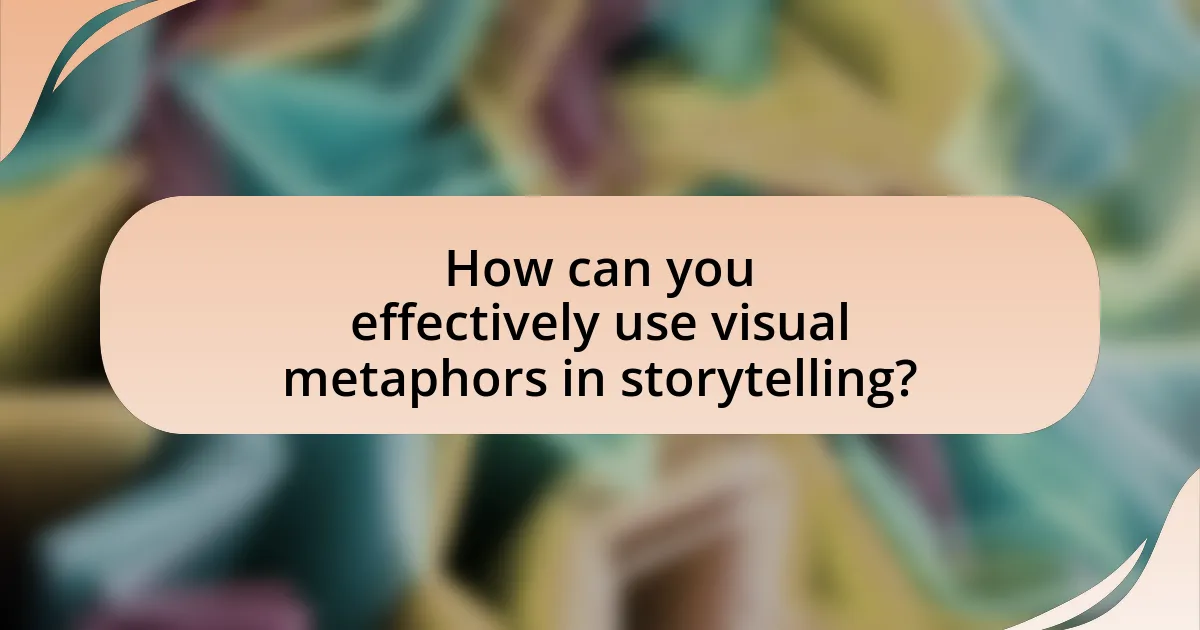
How can you effectively use visual metaphors in storytelling?
To effectively use visual metaphors in storytelling, integrate imagery that resonates with the themes and emotions of the narrative. This technique enhances understanding and engagement by allowing audiences to draw connections between the metaphor and the story’s deeper meanings. For instance, using a storm to symbolize internal conflict can evoke strong emotional responses, as seen in classic literature where weather reflects character turmoil. Research indicates that visual metaphors can improve retention and comprehension, as they create mental images that are easier to remember than abstract concepts.
What techniques can be employed to create visual metaphors?
Techniques to create visual metaphors include juxtaposition, symbolism, and abstraction. Juxtaposition involves placing two contrasting images side by side to highlight their differences and create a new meaning, such as showing a flower next to a skull to represent life and death. Symbolism uses recognizable images to convey deeper meanings, like a broken chain symbolizing freedom from oppression. Abstraction simplifies complex ideas into visual forms, allowing viewers to interpret the metaphor based on their experiences, such as using a maze to represent life’s challenges. These techniques effectively enhance storytelling by engaging the audience’s imagination and emotions.
How can symbolism be integrated into visual metaphors?
Symbolism can be integrated into visual metaphors by using recognizable images that convey deeper meanings related to the narrative. For instance, a broken chain can symbolize freedom from oppression, while a rising sun may represent hope or new beginnings. This integration enhances storytelling by allowing viewers to interpret the visual elements on multiple levels, enriching their understanding of the underlying themes. Research in visual communication indicates that metaphors can significantly influence audience perception, as demonstrated in studies like “The Role of Metaphor in Visual Communication” by Forceville, which highlights how visual metaphors facilitate cognitive engagement and emotional resonance.
What are some examples of successful visual metaphors in literature and film?
Successful visual metaphors in literature and film include the green light in “The Great Gatsby,” symbolizing unattainable dreams, and the use of the red balloon in “The Red Balloon,” representing childhood innocence and freedom. In “The Great Gatsby,” the green light at the end of Daisy’s dock serves as a powerful metaphor for Gatsby’s hopes and aspirations, illustrating the theme of the American Dream. Similarly, in “The Red Balloon,” the balloon’s journey through the streets of Paris visually conveys the joy and simplicity of childhood, contrasting with the adult world’s complexities. These examples demonstrate how visual metaphors can effectively enhance thematic depth and emotional resonance in storytelling.
How do you identify the right visual metaphor for your story?
To identify the right visual metaphor for your story, analyze the core themes and emotions you wish to convey. This involves understanding the central message and the feelings associated with it, which can guide you in selecting a metaphor that resonates with your audience. For instance, if your story explores themes of growth and transformation, a visual metaphor like a blossoming flower or a butterfly emerging from a cocoon can effectively illustrate these concepts. Research indicates that effective visual metaphors enhance comprehension and retention of the narrative, as they create relatable imagery that connects with the audience’s experiences.
What factors should be considered when choosing a visual metaphor?
When choosing a visual metaphor, clarity, relevance, and audience perception are critical factors. Clarity ensures that the metaphor effectively communicates the intended message without confusion. Relevance guarantees that the metaphor aligns with the core theme or message of the story, enhancing the audience’s understanding. Audience perception is vital as it considers the cultural and contextual backgrounds of the viewers, ensuring that the metaphor resonates with them. For instance, a study by the University of California found that metaphors closely tied to the audience’s experiences significantly improve engagement and comprehension.
How can audience demographics influence metaphor selection?
Audience demographics significantly influence metaphor selection by determining the cultural, social, and experiential contexts that shape understanding. For instance, younger audiences may resonate more with digital or contemporary metaphors, while older demographics might connect better with traditional or historical references. Research indicates that metaphors aligned with the audience’s background enhance comprehension and engagement, as seen in studies like “The Role of Metaphor in Communication” by Lakoff and Johnson, which highlight how shared experiences and cultural knowledge facilitate metaphorical interpretation. Thus, tailoring metaphors to specific demographic characteristics ensures effective communication and storytelling.
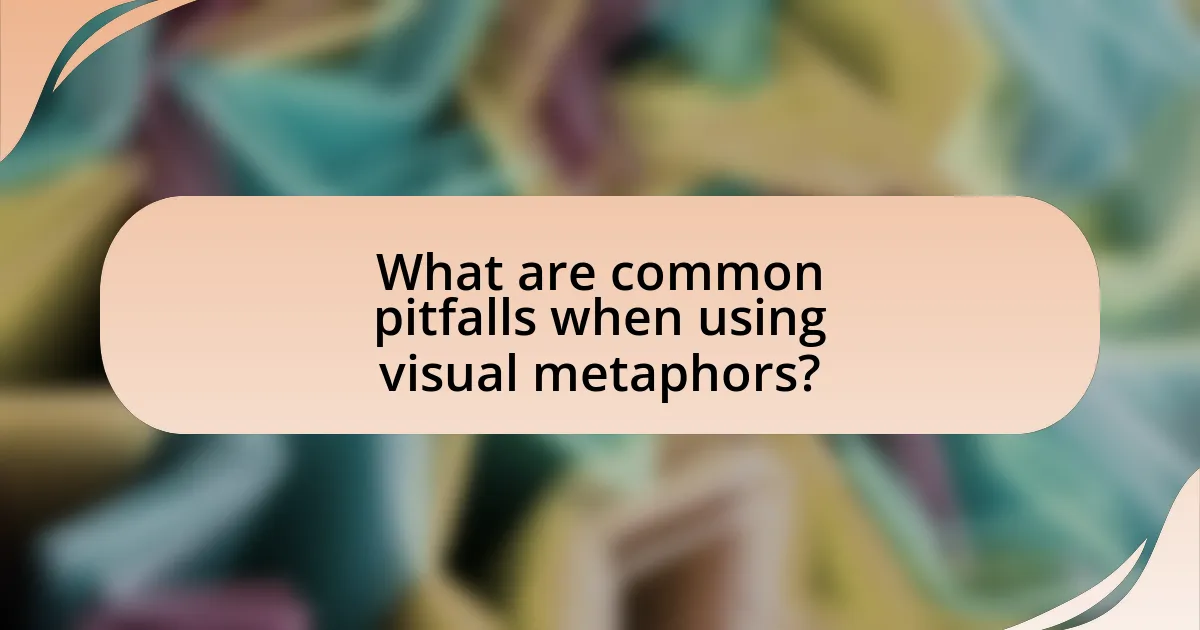
What are common pitfalls when using visual metaphors?
Common pitfalls when using visual metaphors include ambiguity, cultural misinterpretation, and overcomplication. Ambiguity arises when the metaphor is not clear, leading to confusion about its intended meaning. Cultural misinterpretation occurs when a visual metaphor does not resonate with or is misunderstood by audiences from different backgrounds, potentially alienating them. Overcomplication happens when the metaphor is too intricate, detracting from the main message and making it difficult for the audience to grasp the intended concept. These pitfalls can undermine the effectiveness of storytelling by obscuring the narrative rather than enhancing it.
What mistakes should be avoided in visual metaphor usage?
Mistakes to avoid in visual metaphor usage include overcomplicating the imagery, which can confuse the audience. When metaphors are too intricate or abstract, they lose their intended impact and clarity. Additionally, failing to align the metaphor with the narrative context can lead to disconnection; for instance, a metaphor that does not resonate with the story’s themes may confuse viewers. Another mistake is using clichés, which can diminish originality and engagement. Research indicates that unique and relevant metaphors enhance audience understanding and retention, while overused ones can lead to disengagement. Lastly, neglecting audience interpretation can result in miscommunication; understanding the audience’s background and perspective is crucial for effective metaphor usage.
How can overuse of visual metaphors detract from storytelling?
Overuse of visual metaphors can detract from storytelling by overwhelming the audience and obscuring the narrative’s core message. When visual metaphors are excessively employed, they can lead to confusion, as viewers may struggle to discern the intended meaning behind each metaphor. This confusion can dilute emotional engagement, as the audience may become distracted by the sheer number of images rather than focusing on the story itself. Research indicates that clarity is essential for effective communication; for instance, a study published in the Journal of Visual Literacy found that excessive imagery can hinder comprehension and retention of information. Thus, while visual metaphors can enhance storytelling, their overuse can ultimately undermine the clarity and impact of the narrative.
What are the risks of using ambiguous visual metaphors?
The risks of using ambiguous visual metaphors include misinterpretation, confusion, and loss of message clarity. Misinterpretation occurs when the audience derives meanings that differ from the intended message, potentially leading to misunderstandings. Confusion arises when the metaphor does not clearly connect to the narrative, causing the audience to disengage or become puzzled. Loss of message clarity can result in the audience failing to grasp the core theme or emotion intended by the storyteller, which diminishes the overall impact of the narrative. Research indicates that clear visual communication enhances audience comprehension, while ambiguity can detract from effective storytelling.
How can you refine your use of visual metaphors?
To refine your use of visual metaphors, focus on clarity and relevance to the narrative. Clear visual metaphors enhance understanding and engagement, while relevant metaphors resonate with the audience’s experiences. Research indicates that effective visual metaphors can improve retention of information by up to 65%, as they create strong mental associations. By analyzing successful examples in storytelling, such as the use of the “journey” metaphor in narratives, you can identify patterns that resonate with audiences and apply them to your own work.
What feedback mechanisms can help improve metaphor effectiveness?
Feedback mechanisms that can help improve metaphor effectiveness include audience testing, peer reviews, and iterative revisions. Audience testing allows creators to gauge how well metaphors resonate with the intended audience, providing insights into clarity and emotional impact. Peer reviews enable collaboration and diverse perspectives, which can highlight potential misunderstandings or suggest enhancements. Iterative revisions based on feedback ensure that metaphors evolve and align more closely with the narrative’s goals, ultimately enhancing storytelling effectiveness. Research indicates that iterative processes in creative work lead to higher quality outcomes, as seen in studies on design and communication effectiveness.
How can collaboration with visual artists enhance metaphor development?
Collaboration with visual artists enhances metaphor development by integrating visual elements that deepen and expand the conceptual understanding of metaphors. This partnership allows for the translation of abstract ideas into tangible imagery, making metaphors more relatable and impactful. For instance, visual artists can create illustrations that embody metaphorical concepts, thereby providing a visual context that enriches the narrative. Research indicates that visual representation can significantly improve comprehension and retention of metaphorical language, as seen in studies where participants demonstrated better recall of metaphorical phrases when accompanied by relevant images. This synergy between visual art and metaphorical language fosters a more immersive storytelling experience, ultimately enhancing the audience’s engagement and interpretation.
What are best practices for incorporating visual metaphors in storytelling?
Best practices for incorporating visual metaphors in storytelling include ensuring clarity, relevance, and emotional resonance. Clarity is essential; visual metaphors should be easily understood by the audience to effectively convey the intended message. Relevance ensures that the metaphor aligns with the story’s themes and characters, enhancing the narrative rather than distracting from it. Emotional resonance is crucial, as effective visual metaphors evoke feelings that deepen the audience’s connection to the story. Research indicates that visual metaphors can enhance memory retention and engagement, as demonstrated in studies on cognitive processing in storytelling.
How can you ensure clarity and impact in your visual metaphors?
To ensure clarity and impact in visual metaphors, use simple and relatable imagery that directly connects to the intended message. Clear visual metaphors resonate with the audience by evoking familiar concepts, making complex ideas more accessible. For instance, using a light bulb to represent an idea leverages a universally understood symbol, enhancing comprehension. Research indicates that visuals can improve retention by up to 65% when paired with relevant metaphors, demonstrating their effectiveness in communication.
What strategies can help maintain consistency in metaphor usage?
To maintain consistency in metaphor usage, establish a clear thematic framework that aligns with the narrative’s core message. This framework serves as a guide for selecting metaphors that resonate with the story’s tone and purpose. For instance, if a story revolves around growth, using metaphors related to nature, such as “blooming” or “roots,” reinforces the theme. Consistent application of these metaphors throughout the narrative enhances coherence and aids audience comprehension. Research indicates that coherent metaphor usage improves reader engagement and retention, as seen in studies on cognitive processing in storytelling.
